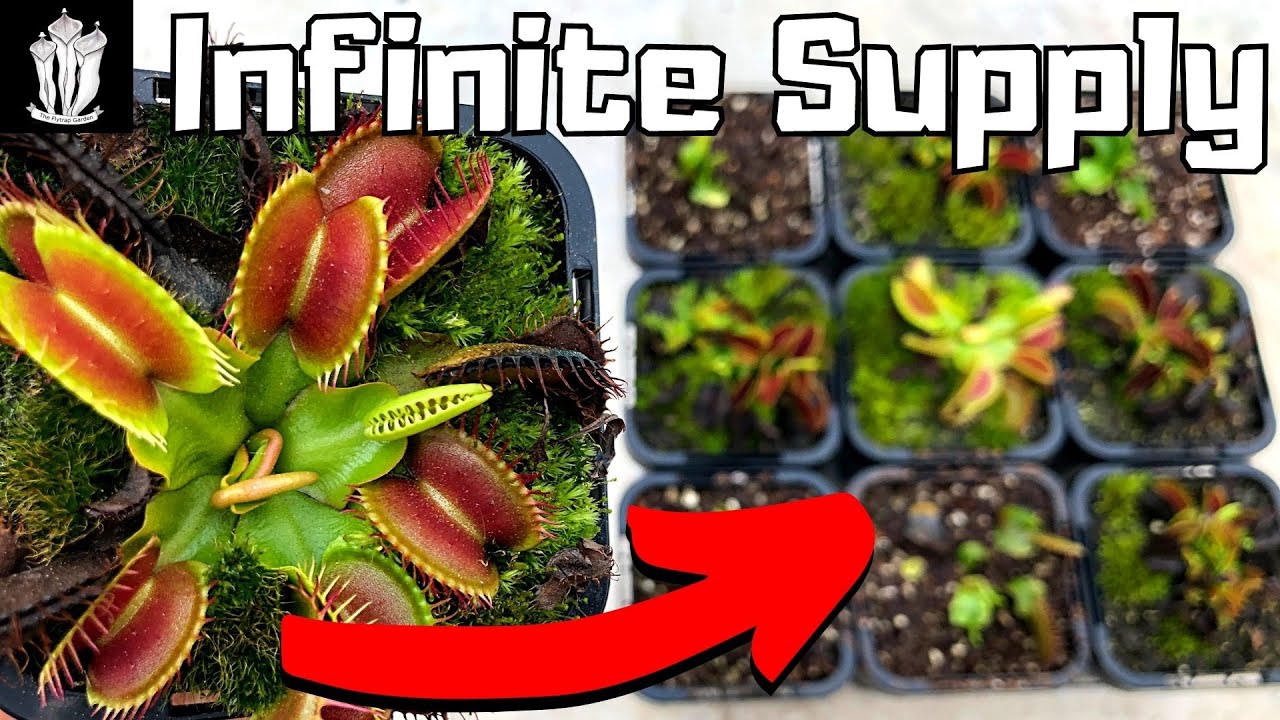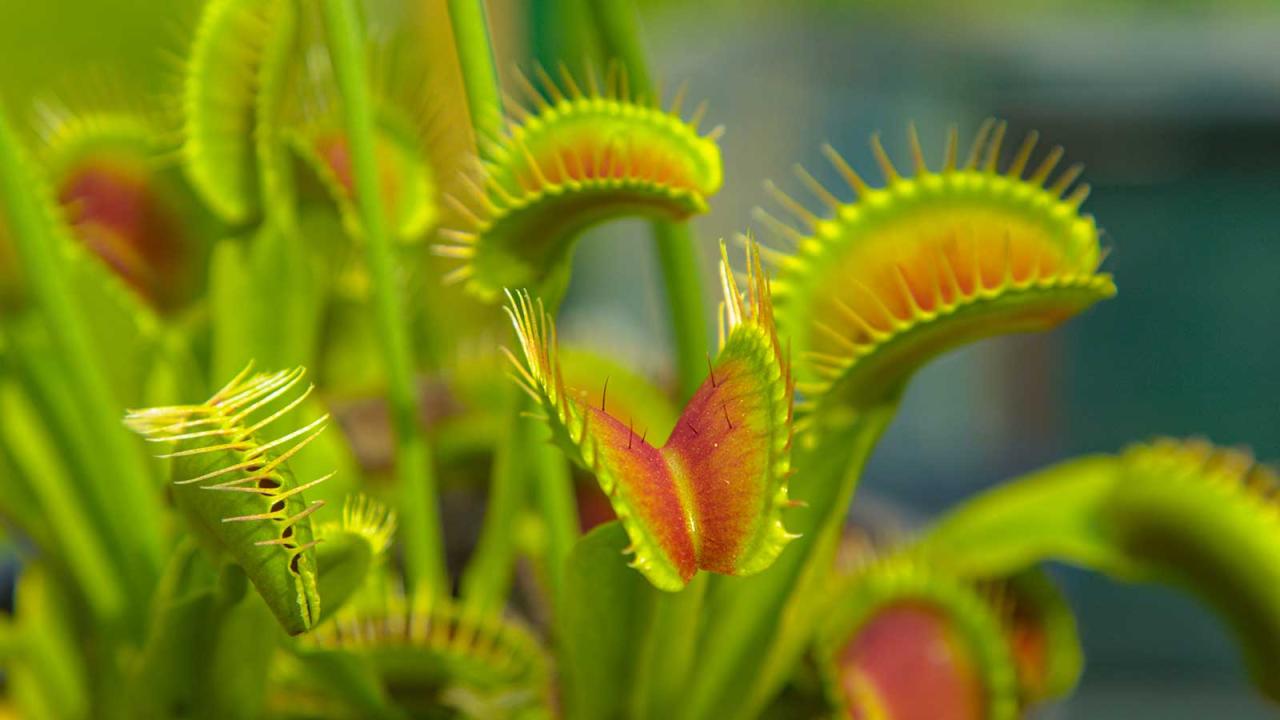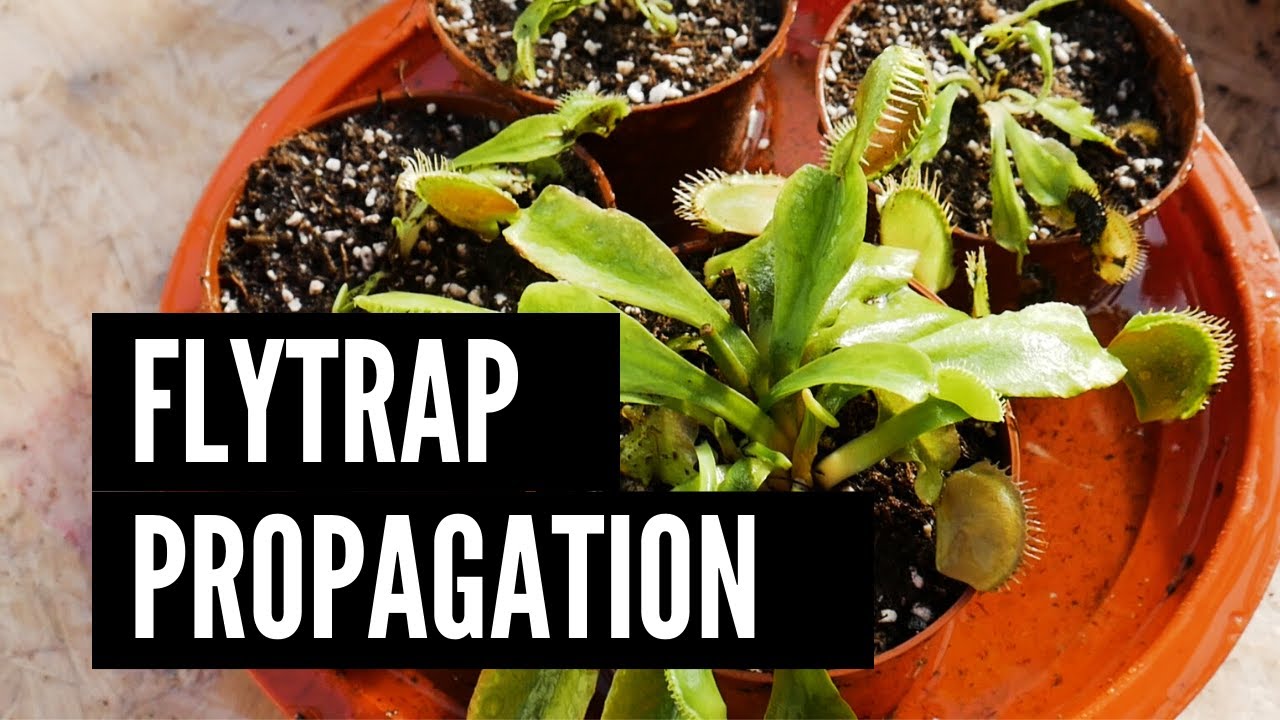Your Venus Fly Trap Isn’t Growing? Try Propagating It With This Method! Have you ever been disheartened by a seemingly lifeless Venus flytrap, its once vibrant traps now shriveled and dormant? You’re not alone. These fascinating carnivorous plants can be finicky, often struggling to thrive in our homes.
But don’t despair! Propagation can be the key to reviving your Venus flytrap and even expanding your collection of these captivating creatures.
Venus flytraps, native to the wetlands of the Carolinas, are renowned for their unique ability to capture insects with their rapid-closing traps. These fascinating plants require specific conditions to thrive, including ample sunlight, moist soil, and a dormant period during winter.
While they are relatively easy to care for, various factors can hinder their growth, leading to frustration for even the most experienced plant enthusiast.
Introduction

For years, my Venus flytrap, affectionately nicknamed “Snappy,” had been a cherished part of my home. But recently, Snappy seemed to be struggling. Its once vibrant green leaves had lost their luster, and its trap movements were sluggish. I was heartbroken, fearing I had lost my beloved carnivorous companion.
However, a bit of research led me to a simple yet effective solution: propagation. By taking a leaf cutting, I was able to cultivate a new, healthy Snappy, bringing back the joy of watching its fascinating traps snap shut.
Venus flytraps (Dionaea muscipula) are carnivorous plants native to the wetlands of North and South Carolina. Their most striking feature is their unique trap mechanism, comprised of two hinged lobes that snap shut with incredible speed, trapping unsuspecting insects.
This fascinating adaptation allows Venus flytraps to thrive in nutrient-poor environments, supplementing their diet with protein-rich insects. Propagation is a crucial technique for preserving the Venus flytrap population. Due to habitat loss and overharvesting, these fascinating plants are considered endangered.
By propagating existing plants, we can help ensure their survival and prevent their extinction.
Why Your Venus Flytrap Isn’t Growing
It’s disheartening to see your beloved Venus flytrap seemingly stagnant, refusing to unfurl new leaves or traps. While it might feel like your plant is struggling, there are several common reasons behind this apparent lack of growth. Understanding these factors can help you diagnose the issue and take appropriate action to revive your carnivorous companion.
Reasons for Growth Stagnation
A Venus flytrap’s growth can be affected by various factors, including insufficient sunlight, improper watering, and nutrient deficiencies.
- Insufficient Sunlight:Venus flytraps thrive in full sun, needing at least six hours of direct sunlight daily. Without adequate sunlight, they may struggle to photosynthesize, leading to stunted growth and pale, weak leaves.
- Improper Watering:These plants prefer consistently moist soil, but overwatering can lead to root rot and impede growth. It’s crucial to use distilled or rainwater and allow the soil to dry slightly between waterings.
- Nutrient Deficiencies:Unlike most plants, Venus flytraps don’t require soil nutrients. In fact, excessive nutrients can be harmful. They obtain their nourishment from insects they catch. If your plant isn’t trapping enough insects, it may experience nutrient deficiencies, hindering growth.
While propagating your Venus flytrap can help rejuvenate your carnivorous friend, sometimes you might crave a different kind of greenery. For a touch of beauty that hangs gracefully, explore the world of stunning hanging plants, as highlighted in The Most Beautiful Hanging Plants for Every Season.
From trailing vines to cascading foliage, these plants offer a captivating visual appeal, adding a touch of nature’s artistry to any space. Once you’ve chosen your perfect hanging companions, remember that your Venus flytrap still needs its unique care, so keep those insects coming!
Dormancy and Its Impact on Growth
Venus flytraps undergo a period of dormancy during the winter months, typically from October to March. During this time, their growth slows down significantly, and they may appear dormant, with no new leaves or traps emerging. This is a natural process and not a sign of a problem.
Just like nurturing a delicate Bonsai tree requires patience and precision, reviving a struggling Venus Fly Trap demands a similar approach. If your carnivorous plant isn’t thriving, consider propagation as a solution. This method allows you to create new, healthy plants from cuttings, ensuring your collection flourishes.
Identifying Specific Growth Issues
The appearance of your Venus flytrap can provide clues about the underlying issue:
- Pale, Weak Leaves:This often indicates insufficient sunlight.
- Yellowing or Brown Leaves:This could be a sign of overwatering, leading to root rot.
- Black or Rotting Roots:This confirms root rot, caused by excessive moisture.
- Stunted Growth:This could be caused by insufficient sunlight, improper watering, or nutrient deficiencies.
The Power of Propagation
If your Venus flytrap isn’t thriving, propagation can be a fantastic way to give it a new lease on life. It involves creating new plants from existing ones, allowing you to rejuvenate your struggling flytrap and even expand your collection.Propagation offers several advantages.
It provides a chance to create multiple plants from a single specimen, effectively multiplying your collection. It also helps preserve genetic diversity, as each new plant inherits the unique traits of the parent.
Methods of Propagation
There are two main methods of propagating Venus flytraps: leaf cuttings and division.
- Leaf Cuttings:This method involves taking a healthy leaf from the Venus flytrap and allowing it to develop roots. The leaf is typically cut near the base, leaving a small portion of the stem attached. It is then placed in a humid environment, such as a sealed container with sphagnum moss, where it will gradually develop roots and eventually produce a new plantlet.
This method is relatively simple and allows for multiple new plants to be grown from a single leaf.
- Division:This method involves separating the Venus flytrap’s root system into multiple divisions, each containing a portion of the original plant. Each division will then grow into a new, independent plant. This method is typically used for mature Venus flytraps that have developed a substantial root system.
It is a quick and efficient way to create multiple plants, but it requires more care and attention than leaf cuttings.
Leaf Cutting Propagation
Leaf cutting propagation is a popular and effective method for multiplying Venus flytraps. It involves taking a healthy leaf and inducing it to grow a new plant from the base. This method is relatively simple and can be successful with proper care.
Leaf Cutting Propagation: A Step-by-Step Guide
Leaf cutting propagation involves taking a healthy leaf from a mature Venus flytrap and placing it in a suitable environment for root and plant development. Here is a detailed step-by-step guide for successful propagation:
Selecting Healthy Leaves
Choose healthy, mature leaves that are at least half the size of the plant. Avoid leaves that are damaged, discolored, or showing signs of disease. The ideal leaves are those that are vibrant green and firm to the touch.
Preparing the Cutting Medium
A suitable cutting medium is crucial for successful propagation. A mixture of peat moss and perlite in a 1:1 ratio is commonly recommended. Peat moss provides essential nutrients and moisture retention, while perlite enhances drainage and aeration.
Placing the Cuttings in a Humid Environment
After preparing the cutting medium, place the cuttings in a humid environment. A propagator or a plastic container with a lid can be used to create a humid environment. This promotes root development and prevents the cuttings from drying out.
Maintaining Proper Temperature and Light Conditions
Maintain a consistent temperature between 70°F and 80°F (21°C to 27°C). The cuttings need bright, indirect light but should be shielded from direct sunlight, which can scorch the leaves.
Tips for Maximizing Success Rate
- Use sterile tools: Sterilize the knife or scissors used to cut the leaves to prevent the introduction of bacteria or fungi.
- Cut the leaves at the base: Ensure the cut is clean and close to the base of the leaf.
- Keep the cutting medium moist: The cutting medium should be consistently moist but not waterlogged.
- Avoid overwatering: Excessive watering can lead to root rot and hinder propagation.
- Monitor the cuttings: Regularly check the cuttings for signs of growth or decay.
Troubleshooting Common Issues
- Mold growth: If mold appears on the cutting medium, gently remove it and replace the medium with fresh, sterile material.
- Root rot: If the cuttings appear mushy or black, root rot may be occurring. Ensure the cutting medium is well-draining and avoid overwatering.
- No growth: If no growth is observed after several weeks, the cuttings may not have rooted. Check the cutting medium for moisture and adjust the temperature or light conditions if necessary.
Essential Tips for Leaf Cutting Propagation
Tip |
Description |
|---|---|
Use a sharp knife or scissors |
Ensures a clean cut, reducing the risk of infection. |
Cut the leaves at the base |
Promotes root development from the base of the leaf. |
Maintain a humid environment |
Helps to prevent the cuttings from drying out. |
Provide bright, indirect light |
Encourages photosynthesis and growth. |
Keep the cutting medium moist |
Provides necessary moisture for root development. |
Avoid overwatering |
Can lead to root rot and hinder propagation. |
Monitor the cuttings regularly |
Allows for early detection of issues and prompt intervention. |
Division Propagation

Division propagation is a simple and effective method for multiplying your Venus flytrap. This technique involves separating a mature plant into multiple smaller plants, each capable of developing into a fully grown Venus flytrap. This method is particularly suitable for experienced growers who have established, healthy plants.
Dividing a Mature Venus Flytrap
Division propagation requires careful handling and sterile tools to prevent damage and infection. When dividing a Venus flytrap, it’s crucial to use sharp, sterile tools to minimize the risk of introducing bacteria or fungi into the plant’s wounds. Gentle handling is essential to avoid damaging the delicate roots and leaves.
Just like choosing the right pot for your bonsai tree is crucial for its growth and development, understanding the needs of your Venus flytrap is key to its thriving. When your Venus flytrap isn’t growing, it’s time to consider propagation methods, which can be as simple as taking cuttings from the plant.
Similar to selecting the appropriate pot for your bonsai, Choosing the Right Bonsai Pot for Every Tree Stage is vital for creating the ideal environment for your plant’s success. By following the right propagation techniques, you can easily rejuvenate your Venus flytrap and enjoy its fascinating carnivorous nature for years to come.
Step-by-Step Guide
- Choose the Right Time:The best time to divide a Venus flytrap is during its active growth period, typically in spring or early summer. Avoid dividing during dormancy (winter), as the plant is more vulnerable to stress.
- Prepare the Plant:Gently remove the plant from its pot and loosen the soil around the roots. Use a sterile knife or sharp gardening tool to separate the plant into individual divisions. Each division should have a healthy root system and at least one growing point.
- Prepare the Pots:Fill individual pots with a suitable potting mix for carnivorous plants, ensuring proper drainage. The pots should be slightly larger than the root ball of each division.
- Plant the Divisions:Carefully place each division into its pot, ensuring the root ball is level with the soil surface. Gently firm the soil around the roots.
- Water and Care:Water the newly planted divisions thoroughly and keep the soil consistently moist. Provide adequate sunlight and humidity. The divisions should start to grow new leaves within a few weeks.
Key Considerations
Factor |
Considerations |
|---|---|
Plant Health |
Ensure the plant is healthy and free from pests or diseases before dividing. |
Sterilization |
Use sterile tools to prevent infection. Sterilize tools with rubbing alcohol or bleach solution. |
Handling |
Handle the plant carefully to avoid damaging roots and leaves. |
Potting Mix |
Use a suitable potting mix for carnivorous plants, ensuring proper drainage. |
Watering |
Water the divisions thoroughly and keep the soil consistently moist. |
Caring for Your New Venus Flytraps: Your Venus Fly Trap Isn’t Growing? Try Propagating It With This Method!
Congratulations! You’ve successfully propagated your Venus flytrap and now have a new plant to nurture. Providing the right care is crucial for your new flytrap to thrive and flourish. This section will guide you through the essential care requirements for your newly propagated Venus flytrap.
Watering and Humidity Requirements
Venus flytraps are native to bogs and swamps, so they require consistently moist soil and high humidity. Here’s how to ensure your new plant gets the right moisture:* Watering:Use distilled or rainwater to avoid mineral buildup in the soil. Water thoroughly when the top inch of soil feels dry.
Humidity
Maintain a humidity level of 40-60% for optimal growth. You can achieve this by placing the pot on a tray filled with pebbles and water, or by using a humidifier.
Avoid Overwatering
While Venus flytraps need moisture, overwatering can lead to root rot. Ensure the pot has good drainage to prevent waterlogging.
Light and Temperature Preferences
Venus flytraps thrive in bright, indirect sunlight. They require a minimum of four hours of direct sunlight per day. * Light:Place your flytrap in a south-facing window or a location with bright, indirect light.
Temperature
Venus flytraps prefer warm temperatures, ideally between 70-90°F (21-32°C) during the growing season. In winter, they enter dormancy and require cooler temperatures (40-50°F (4-10°C)).
Feeding Guidelines
Venus flytraps are carnivorous plants that supplement their diet by trapping insects. While they can survive on their own, feeding them can help them grow faster and stronger.* Feeding Frequency:Feed your flytrap every 2-3 weeks during the growing season.
Insect Size
Only feed your flytrap insects that are no larger than one-third the size of the trap.
Live Prey
It’s best to feed your flytrap live insects, as they provide essential nutrients. Avoid feeding them dead insects, as they can attract bacteria and fungi.
Recognizing Signs of Healthy Growth
A healthy Venus flytrap will exhibit several signs of good growth:* New Growth:Look for new leaves and traps emerging from the center of the plant.
Strong Trap Closure
The traps should close tightly when stimulated by prey.
Vibrant Color
The leaves should be a vibrant green color.
Healthy Root System
The roots should be white and firm.
Care Table for Different Stages of Growth, Your Venus Fly Trap Isn’t Growing? Try Propagating It With This Method!
Stage of Growth |
Watering |
Humidity |
Light |
Temperature |
Feeding |
|---|---|---|---|---|---|
Newly Propagated |
Water thoroughly when the top inch of soil feels dry |
40-60% |
Bright, indirect sunlight |
70-90°F (21-32°C) |
No feeding for the first month |
Active Growth |
Water thoroughly when the top inch of soil feels dry |
40-60% |
4 hours of direct sunlight |
70-90°F (21-32°C) |
Feed every 2-3 weeks with live insects |
Dormancy |
Water sparingly |
40-60% |
Cool, bright light |
40-50°F (4-10°C) |
Do not feed |
Conclusion

Propagation is a valuable tool for Venus flytrap owners, offering a way to expand your collection, share these fascinating plants with others, and ensure the long-term health and vitality of your Venus flytraps. By taking advantage of the natural ability of Venus flytraps to reproduce through leaf cuttings and division, you can create new plants from existing ones, contributing to the conservation and enjoyment of these remarkable carnivorous plants.
Resources for Further Information
There are numerous resources available to provide additional information and guidance on Venus flytrap care and propagation.
- The International Carnivorous Plant Society (ICPS): The ICPS is a non-profit organization dedicated to the study, conservation, and cultivation of carnivorous plants. Their website offers a wealth of information on Venus flytraps, including propagation techniques, care guides, and a forum for connecting with other enthusiasts.
- Sarracenia Northwest: This website provides comprehensive information on the cultivation and propagation of Venus flytraps, as well as other carnivorous plants. It includes detailed guides, resources, and a shop for purchasing Venus flytraps and supplies.
- The Carnivorous Plant FAQ: This website offers a comprehensive guide to the care and cultivation of Venus flytraps and other carnivorous plants. It covers a wide range of topics, including propagation, feeding, and troubleshooting common problems.
Ending Remarks
Don’t let a struggling Venus flytrap dampen your enthusiasm for these captivating plants. By embracing propagation, you can breathe new life into your existing plant, create a thriving collection, and experience the joy of nurturing these carnivorous wonders from their earliest stages.
So, grab a healthy leaf, a sterile tool, and a bit of patience, and embark on the rewarding journey of propagating your own Venus flytraps. You might just be surprised by the incredible results and the satisfaction of witnessing these fascinating plants flourish under your care.
FAQ Section
What are the signs of a healthy Venus flytrap?
A healthy Venus flytrap will have vibrant green leaves, strong traps, and a consistent growth rate.
How often should I feed my Venus flytrap?
You should only feed your Venus flytrap live insects, and only when it is actively growing.
Can I use tap water to water my Venus flytrap?
Tap water can contain minerals that can harm your Venus flytrap. It is best to use distilled or rainwater.
What is the best way to store my Venus flytrap during dormancy?
During dormancy, it is best to keep your Venus flytrap in a cool, dark place. You can also store it in a refrigerator.
